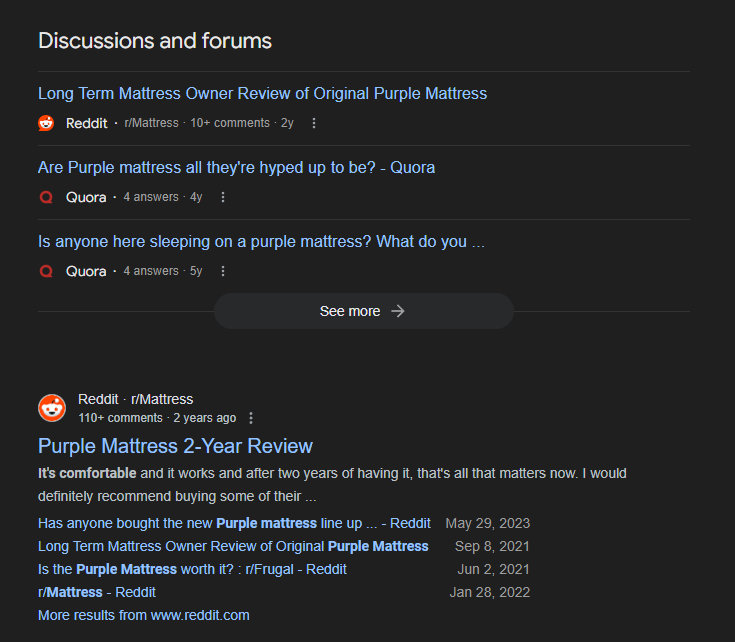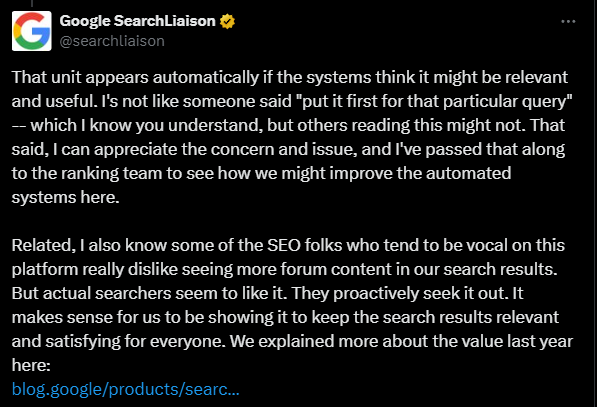SEO
Why Every Marketer Should Be On Reddit

In its nearly 20 years of existence, Reddit has built a robust, dynamic, and highly engaged community.
It has cemented itself as not only one of the key influencers for the internet culture we have come to know today, but also as one of the top 10 social media sites in the world, with more than 500,000 monthly visitors across more than 100,000 active communities.
Despite its size and influence, marketers have long avoided, overlooked, and failed to establish a presence on what is arguably one of the most influential social media sites today.
To be fair, Reddit has always been known as one of the hardest communities to have marketing success with, requiring months (if not years) of dedicated commitment to actually being a part of the community and engaging with your audience through meaningful, genuine, and honest interactions.
To many, that is just too much risk and too much work, but let’s be honest – most amazing things take risk and hard work. And for all of you who put in that work to be successful on Reddit, you already see the payoff it brings.
Regardless of the reasons, marketers who continue to overlook Reddit’s potential are missing out on an extremely influential community with ideal targeted demographics, where authenticity and genuine connections lead to valuable information, positive branding, and marketing success.
Not convinced? Let’s take a closer look at Reddit!
Reddit Stats You Cannot Ignore
Reddit users are dedicated to their use of the platform, with a reported 82 million (16.4%) of its 500 million users visiting the site daily, sharing over 1 billion posts, with over 16 billion comments across 100,000+ active communities, making it easily one of the top visited and most active sites in the United States today.
The user base is so loyal that they spend, on average, 20 minutes on the platform each day (and over 45 minutes a day for long-time users of more than 7 years) and, in many cases, are inactive on other social platforms.
This makes Reddit one of the only places to actually get in front of this massive audience, with 32% being inactive on Facebook, 37% on Instagram, 41% on TikTok, and 53% on X.
When it comes to demographics, a 2019 survey concluded that the overall Reddit audience was majority male (59%), ranged in age (36% aged 18-29; 25% aged 30-49), and well educated (42% college degree; 31% some college) making them an ideal audience many businesses looking for success.
They also helped Reddit improve revenues by 21% to $804 million in 2023, with a global addressable market for advertising estimated at $1.4 trillion by 2027.
Thought by many to be mostly a North American audience, Reddit claims more than 50% of its traffic comes from international users, a rather impressive climb from its earlier years.
It is important to remember, though, that Reddit is a platform that allows communities to grow and thrive, so those demographics change from subreddit to subreddit.
If that isn’t enough to grab your attention, surveys have found that 75% of users find Reddit a trustworthy source for making purchasing decisions.
For years now, it has been included heavily and prominently in Google search results, which have become even more visible due to reports following their inclusion in SGE results and with Google’s recent $60 million a year deal with Reddit to have real-time access to Reddit content and to use its content to train Google’s future AI models.
Speaking of Reddit’s visibility in Google’s search results, let’s take a closer look at why that deal is so important, especially to search marketers.
Reddit In Google Search, SGE, And Google’s Reddit Deal
For years, Reddit results have been prominently displayed in Google’s search results – so much so that users have even started adding the term “reddit” to the end of their search queries.
So often, you will see Google suggest search lines with the term “reddit” prefilled at the end.
Even without selecting the query that includes “reddit,” you will notice Reddit’s prominent placement in two places: discussions and forums, and Reddit sitelinks, which are both just below the ads and the first organic result.
 Screenshot by author from search for [are purple mattresses good], Google, May 2024
Screenshot by author from search for [are purple mattresses good], Google, May 2024This was amplified by Google’s recent Helpful Content Update (HCU), which allowed platforms like Reddit and other forums to show up more frequently in search results,
Reddit’s ability to be helpful in satisfying a user’s search for information is so successful – in combination with reported shortages in new content for AI models from all major platforms – it is not surprising Google struck a deal with Reddit to show its content faster in search results and to use the content in training future AI models.
Since news of the deal between Reddit and Google was reported, there has been a lot of additional focus on Reddit’s visibility in Google’s search results.
Experts throughout the search industry report an increase in not only the total visibility of Reddit going up within search but also the speed at which a Reddit post is indexed and shown to users.
Google responded to concerns about Reddit showing up more in search results, saying that “some of the SEO folks who tend to be vocal on this platform (X) really dislike seeing more forum content in our search results. But actual searchers seem to like it. They proactively seek it out. It makes sense for us to be showing it to keep the search results relevant and satisfying for everyone.”
 Screenshot by author from X (Twitter), May 2024
Screenshot by author from X (Twitter), May 2024Although disputed by Google, Roger Montii wrote about one report of Reddit content being indexed within five minutes.
ChatGPT to Surface Reddit Content
Adding to the deal Reddit made with Google, it was recently reported that OpenAI has partnered with Reddit to surface their content in ChatGPT, adding to the clear value that both OpenAI and Google see in Reddit’s content today and in the future.
Of course, this has sparked a lot of interest in companies of all sizes. They want to figure out how their brands can participate and succeed on Reddit in hopes of increasing their visibility in Google’s search results, SGE, and ChatGPT and building their brand’s visibility amongst one of the most influential audiences on the internet today.
**Quick warning: Reddit requires genuine, long-term engagement and a strategy for success. So, I would definitely advise individuals and businesses to avoid trying to game, spam, or blindly jump into marketing on Reddit and take the time to really understand the platform, its audience, and your place of value within its communities.
Let’s look at how some major brands have been successful on Reddit in the past.
noosa Yoghurt
Noosa Yoghurt’s 2021 back-to-school campaign on Reddit was a great example of tapping into niche audiences to create engaging, user-driven content.
To capitalize on Reddit’s community of vocal yogurt enthusiasts, noosa launched a Flavor Poll that invited Redditors to upvote their favorite noosa flavors in the comments. This created a sense of community and interactivity around what could have been a standard poll.
 Screenshot by author from Reddit, May 2024
Screenshot by author from Reddit, May 2024After tallying the upvotes, noosa published a Promoted Post that showcased the results using a sleek custom infographic, highlighting the community’s favorites while also giving the brand important insight into consumer preferences.
 Screenshot by author from Reddit, May 2024
Screenshot by author from Reddit, May 2024The results:
- 49% increase in brand recall among Reddit users who were exposed to the campaign.
- 30% increase in brand favorability.
- 39% increase in purchase intent (15X the typical lift observed in the food vertical).
- 50+ billion monthly views.
Sony Pictures Germany
To drum up excitement around the release of “Spider-Man: Across the Spider-Verse” in Germany, Sony Pictures Germany crafted a Reddit campaign that combined organic and promoted content to engage the platform’s robust fan communities.
The brand created a Reddit account under the protagonist’s name, u/MilesMorales, and used it to share exclusive content directly within Spiderman-related subreddits.
It also organized an AMA with the German voice actor Miles Morales to create a more personal connection with fans and promoted video posts featuring the movie trailer to amplify the excitement.
 Screenshot by author from Reddit, May 2024
Screenshot by author from Reddit, May 2024The results:
- Sony Pictures Germany achieved a click-through rate (CTR) that was 344% higher than that of its standard paid media.
- 831 upvotes.
- 618,000 impressions.
- The film remained No. 1 on the German movie charts for three consecutive weeks.
It is important to note that promoting your content and your brand on Reddit is definitely not the only value Reddit can bring you and your business.
Reddit is an amazing place to get honest feedback.
Whether you are trying to figure out what your target audience wants from your brand, test out a new feature or concept before investing and launching it openly, or even just to have continued open communication with your customers to support them and keep them connected to your brand, Reddit can help you succeed in an amazing way.
Transamerica Helping Reddit Make Dollars Make Sense
Transamerica’s campaign on Reddit is a great example of a company identifying an opportunity to connect with its target audience on the subreddit /r/finance.
This allows the company to better understand its customers’ needs and focus on content creation and future marketing plans.
 Screenshot by author from Reddit, May 2024
Screenshot by author from Reddit, May 2024Aligning itself with its audience by demonstrating awareness of the topics around personal finance happening in the subreddit, as well as acknowledging the Redditors working at the company, it asked what topics it could create “specifically for the reddit community” around the topic of finance.
It stayed involved and engaged throughout the campaign, responding to threads and maintaining a lighthearted and sometimes humorous tone.
 Screenshot by author from Reddit, May 2024
Screenshot by author from Reddit, May 2024After getting all the feedback it needed, it created content around the more popular requests, going as far as branding and designing them similar to Reddit.
 Screenshot by author from Reddit, May 2024
Screenshot by author from Reddit, May 2024It even took the time to individually comment a link to the published content on its site, bringing attention back to the overall campaign and the content it created.
This campaign was 10 years ago, and it is still referenced as a core example of engaging on Reddit as a brand in a respectful, thoughtful, and meaningful way.
Why You Should Be On Reddit Wrapup
TL;DR: If your brand has something meaningful to say and is interested in truly connecting with your audience, then yes, you should be on Reddit.
These successful brand campaign examples showcase Reddit’s power when used correctly. With research to understand the specific communities you want to reach, Reddit can have exceptional performance compared to other channels.
The stakes are high to get it right because Reddit communities can be highly negative toward self-serving promotion. But if you put in the effort and solve people’s needs and problems, Reddit has the potential to be a high-performance channel.
Edit: Updated daily active users figure based on Reddit’s Q1 Earnings Report
More resources:
Featured Image: Julia Tim/Shutterstock

![How AEO Will Impact Your Business's Google Visibility in 2026 Why Your Small Business’s Google Visibility in 2026 Depends on AEO [Webinar]](https://articles.entireweb.com/wp-content/uploads/2026/01/How-AEO-Will-Impact-Your-Businesss-Google-Visibility-in-2026-400x240.png)
![How AEO Will Impact Your Business's Google Visibility in 2026 Why Your Small Business’s Google Visibility in 2026 Depends on AEO [Webinar]](https://articles.entireweb.com/wp-content/uploads/2026/01/How-AEO-Will-Impact-Your-Businesss-Google-Visibility-in-2026-80x80.png)















